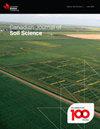Nitrogen use efficiency of wheat and canola from urea treated with different types of double inhibitors
IF 1.5
4区 农林科学
Q4 SOIL SCIENCE
引用次数: 0
Abstract
Abstract Urease inhibitor (specifically, N-(n-butyl) thiophosphoric triamide, NBPT) and nitrification inhibitors (NIs) have been used to minimize nitrogen (N) loss from urea. However, their effects on improving crop N use efficiency (NUE) are usually inconsistent. A 2-year study was conducted to determine the best combination of NBPT and different NIs on urea that will maximize NUE while reducing nitrate leaching. Treatments consisted of untreated urea, NBPT-treated urea, and six types of (NBPT + NI)-treated urea that were surface applied at 80 kg N ha−1 on plots seeded to canola (2019) and wheat (2020) at Carman and Portage in Manitoba, Canada. Plots at Carman had lysimeters installed to measure leached water and nitrate. The sites had at least 35% lesser rainfall than climate normal during each growing season. At each site, average grain yields, N removal, and residual nitrate were not significantly different between untreated urea and inhibitor-treated urea. Over the 2 years, there was no significant benefit of NBPT or NBPT + NI on crop NUE at each site. Cumulative leached nitrate (19–40 kg N ha−1) did not differ significantly among urea treated with and without inhibitors. This is because >50% of the precipitation occurred when the effectiveness of NI had elapsed. Although NBPT and NI are known to reduce N losses to the atmosphere, this study suggests that the agronomic benefit and nitrate leaching prevention by NI applied in the spring may be limited in regions where large precipitation occurs later in the growing season or during non-growing season.不同类型双抑制剂对小麦和油菜氮素利用效率的影响
脲酶抑制剂(特别是N-(正丁基)硫代磷酸三酰胺,NBPT)和硝化抑制剂(NIs)已被用于减少尿素中的氮(N)损失。然而,它们对提高作物氮素利用效率(NUE)的作用往往不一致。一项为期2年的研究旨在确定NBPT和不同NIs对尿素的最佳组合,以最大限度地提高氮肥利用效率,同时减少硝酸盐淋失。处理包括未经处理的尿素、NBPT处理的尿素和六种(NBPT + NI)处理的尿素,在加拿大曼尼托巴省卡尔曼和波蒂奇的油菜(2019)和小麦(2020)地块表面施用80 kg N / h - 1。在卡门的地块上安装了溶渗仪来测量浸出的水和硝酸盐。在每个生长季节,这些地点的降雨量至少比正常气候少35%。在每个试验点,未处理尿素和抑制剂处理尿素的平均籽粒产量、氮去除率和残留硝酸盐均无显著差异。在2年内,NBPT或NBPT + NI对每个站点的作物氮肥利用率没有显著的改善。尿素的累积浸出硝酸盐(19-40 kg N ha - 1)在添加和未添加抑制剂的尿素中没有显著差异。这是因为50%的降水发生在NI的有效性已经失效的时候。虽然NBPT和NI可以减少氮向大气的损失,但本研究表明,在生长季节后期或非生长季节降水较多的地区,春季施用NI的农艺效益和硝酸盐淋失预防可能有限。
本文章由计算机程序翻译,如有差异,请以英文原文为准。
求助全文
约1分钟内获得全文
求助全文
来源期刊

Canadian Journal of Soil Science
农林科学-土壤科学
CiteScore
2.90
自引率
11.80%
发文量
73
审稿时长
6.0 months
期刊介绍:
The Canadian Journal of Soil Science is an international peer-reviewed journal published in cooperation with the Canadian Society of Soil Science. The journal publishes original research on the use, management, structure and development of soils and draws from the disciplines of soil science, agrometeorology, ecology, agricultural engineering, environmental science, hydrology, forestry, geology, geography and climatology. Research is published in a number of topic sections including: agrometeorology; ecology, biological processes and plant interactions; composition and chemical processes; physical processes and interfaces; genesis, landscape processes and relationships; contamination and environmental stewardship; and management for agricultural, forestry and urban uses.
 求助内容:
求助内容: 应助结果提醒方式:
应助结果提醒方式:


